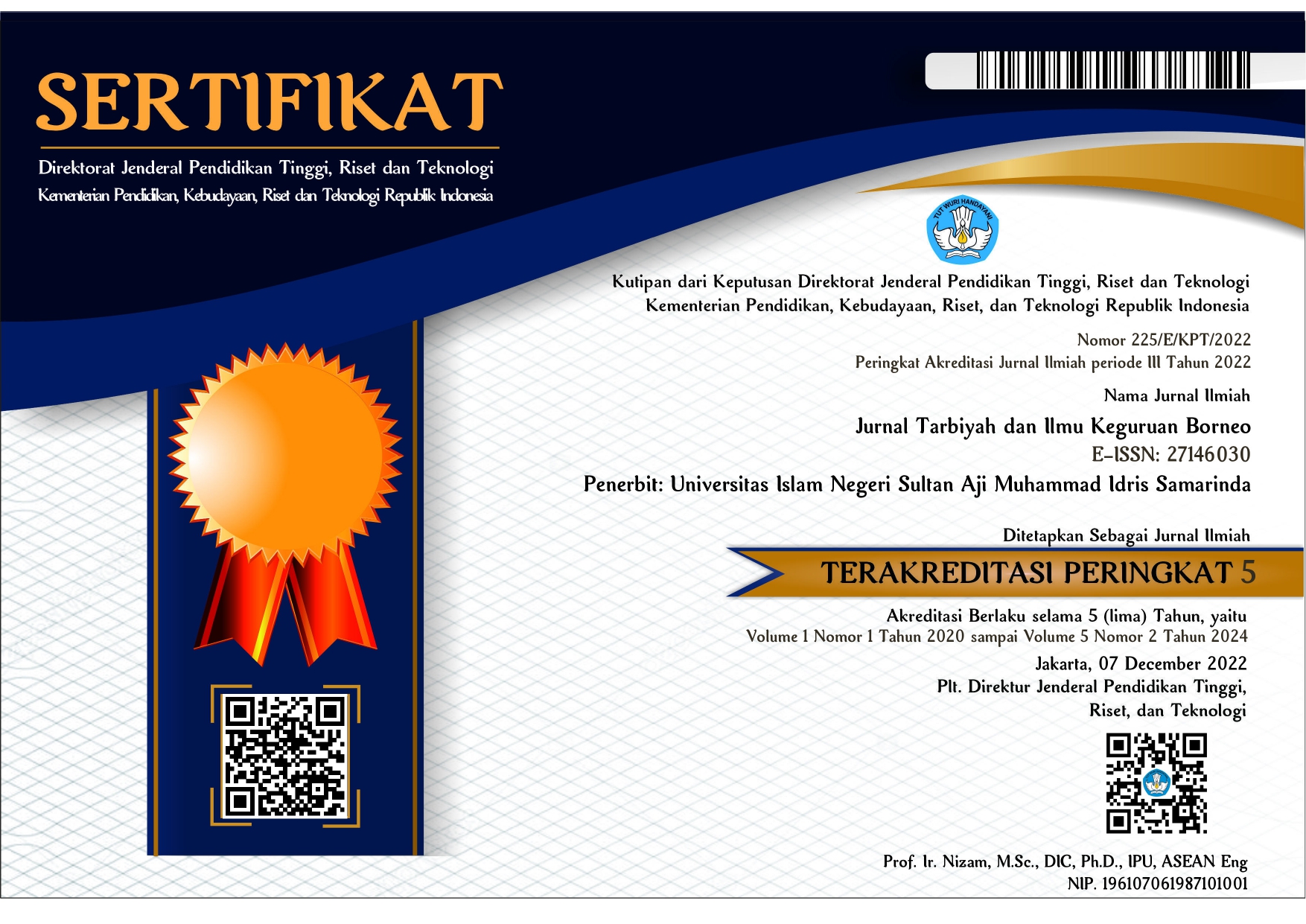The Use of Mobile Assisted Language Learning in English Learning of Fourth Semester English Department Students at IAIN Samarinda
Keywords:
Mobile Assisted Language Learning (MALL), English Learning, Mobile Devoces, Mobile Learning
Abstract
Mobile Assisted Languge Learning, (MALL,) is a learning tool focused on language learning that used mobile phone. MALL in English learning is handy for students who in need to enhancing their English skills. Especially English department students at IAIN Samarinda, they were required to master the primary English language skill to support the learning process. The research objective was to knew students perspective toward the use of MALL in English learning, how do studnets use MALL to support their English learning activities in English and their perpective toward the advantages and disadvantages of utilizing MALL. The instrument was interview conducted by a brief introduction to the subject of the study and then selected students based on their last GPA. Based on the data finding, MALL are indeed useful and bring advantages for students. They share their experience in using MALL for English learning to facilitate, save time and energy, easy theory learning and information access, and improve motivation. However, besides the advantages MALL can provide, it also has its disadvantages. The students shared that the mobile phone is too small so that it is difficult to type, the application of online classes is not yet perfect, the source of material that cannot be trusted completely and the difficulty of internet access that requires money is limited for some studentsReferences
Alsied, Safia & Ibrahim, Naura. (2017). Exporing challenges encounter by EFL. IAFOR, .3(2), 2017.
Al-Tameemy, Farooq. (2017). Mobile Phones for Teaching and Learning: Implementation and Students’ Attitudes. Journal F Educational Technology Systems, 3(45), 2017.
BenMoussa, Chihab. (2003). Workers on the move: New opportunities through mobile commerce”. Stockholm Mobility Roundtable, 2003.
Burston, Jack. (2014) Mobile-assisted language learning: A selected annotated bibliography of implementation studies”, ILTJournal, 17(3), 2014.
Ekenci, Mithat & Ecem Ekenci. (2017) Perceptions of EFL Learners About Using Mobile Applications for English Language Learning”. Researchgate, 5(5), 2017.
Farhana, Nurul. (2018). Students Perception Of Using Mobile Applications. Malaysia: University Technology Malaysia.
Goodison, Terence . (2001). The implementation of e-learning in uk higher education. World Conference On Educational Media And Technology, 2001
Inayati, Dian & Ive Emaliana. (2017). The Relationship among Pre-Service EFL Teachers’ Beliefs about Language Learning, Pedagogical Beliefs, and Beliefs about ICT Integration. Dinamika Ilmu ,17, 2017.
Kirkpatrick, Andy. (2014) The Routledge Companion To English Studies. Routledge.
Klimova, Blanka. (2019). Impact of mobile learning on students’ achievement results”, “Impact of mobile learning on students’ achievement results. Educ SCI, 9(2), 2019.
Kukulska-Hulme, Agnes & John Shield. (2012). An Overview of Mobile Assisted Language Learning:Can mobile devices support collaborative practice inspeaking and listening?. UK Intellect Research Group, 2012.
Magno. (2010). Korean Students' Language Learning Strategies and Years of Studying English as Predictors of Proficiency in English. Tesol Journal, 39(2), 2010.
Magogwe & Oliver. (2017). The Relationship Between Language Learning Strategies, Proficiency, Age And Self-Efficacy Beliefs: A Study Of Language Learners In Botswana. Journal System, 35(3), 2017.
Meschyan, & Hernandez. (2002). Is Native-Language Decoding Skill Related To Second-Language Learning?. Journal Of Educational Psychology, 94(1), 2002.
Miangah, & Nezaret. (2012). Mobile-Assisted Language Learning. International Journal Of Distributed And Parallel Systems, 3(1), 2012.
Newhouse, Paul., John Williams & Jennifer Pearson. (2006). Supporting mobile education for pre-service teachers. Australian Journal Of Educational Technology, 22(3), 2006.
O’Malley, Claire. (2012). Guidelines for learning/teaching/tutoring in a mobile environment. Humanities And Socical Science, 11(1), 2012.
Ogata & Uosaki, (2012). A new trend of mobile and ubiquitous learning research: towards enhancing ubiquitous learning experiences. Mobile Learning And Organisation, .6(1), 2012.
Shahida, Naz., Rasheed Memona, & Rasheed Tahir. (2019). The Role of Mobile phoness in Learning English:A Study of Learners’ Perspectives. London: International Conference on Research in Humanities.
Sharples, Miles. (2000). The design of personal mobile technologies for lifelong learning. Computers & Education, 34(4), 2000.
Shoaib, Mohd. (2017). An Investigation of Effectiveness of Mobile Learning Apps in Higher Education in India. Researchgate, 2(1), 2017.
Al-Tameemy, Farooq. (2017). Mobile Phones for Teaching and Learning: Implementation and Students’ Attitudes. Journal F Educational Technology Systems, 3(45), 2017.
BenMoussa, Chihab. (2003). Workers on the move: New opportunities through mobile commerce”. Stockholm Mobility Roundtable, 2003.
Burston, Jack. (2014) Mobile-assisted language learning: A selected annotated bibliography of implementation studies”, ILTJournal, 17(3), 2014.
Ekenci, Mithat & Ecem Ekenci. (2017) Perceptions of EFL Learners About Using Mobile Applications for English Language Learning”. Researchgate, 5(5), 2017.
Farhana, Nurul. (2018). Students Perception Of Using Mobile Applications. Malaysia: University Technology Malaysia.
Goodison, Terence . (2001). The implementation of e-learning in uk higher education. World Conference On Educational Media And Technology, 2001
Inayati, Dian & Ive Emaliana. (2017). The Relationship among Pre-Service EFL Teachers’ Beliefs about Language Learning, Pedagogical Beliefs, and Beliefs about ICT Integration. Dinamika Ilmu ,17, 2017.
Kirkpatrick, Andy. (2014) The Routledge Companion To English Studies. Routledge.
Klimova, Blanka. (2019). Impact of mobile learning on students’ achievement results”, “Impact of mobile learning on students’ achievement results. Educ SCI, 9(2), 2019.
Kukulska-Hulme, Agnes & John Shield. (2012). An Overview of Mobile Assisted Language Learning:Can mobile devices support collaborative practice inspeaking and listening?. UK Intellect Research Group, 2012.
Magno. (2010). Korean Students' Language Learning Strategies and Years of Studying English as Predictors of Proficiency in English. Tesol Journal, 39(2), 2010.
Magogwe & Oliver. (2017). The Relationship Between Language Learning Strategies, Proficiency, Age And Self-Efficacy Beliefs: A Study Of Language Learners In Botswana. Journal System, 35(3), 2017.
Meschyan, & Hernandez. (2002). Is Native-Language Decoding Skill Related To Second-Language Learning?. Journal Of Educational Psychology, 94(1), 2002.
Miangah, & Nezaret. (2012). Mobile-Assisted Language Learning. International Journal Of Distributed And Parallel Systems, 3(1), 2012.
Newhouse, Paul., John Williams & Jennifer Pearson. (2006). Supporting mobile education for pre-service teachers. Australian Journal Of Educational Technology, 22(3), 2006.
O’Malley, Claire. (2012). Guidelines for learning/teaching/tutoring in a mobile environment. Humanities And Socical Science, 11(1), 2012.
Ogata & Uosaki, (2012). A new trend of mobile and ubiquitous learning research: towards enhancing ubiquitous learning experiences. Mobile Learning And Organisation, .6(1), 2012.
Shahida, Naz., Rasheed Memona, & Rasheed Tahir. (2019). The Role of Mobile phoness in Learning English:A Study of Learners’ Perspectives. London: International Conference on Research in Humanities.
Sharples, Miles. (2000). The design of personal mobile technologies for lifelong learning. Computers & Education, 34(4), 2000.
Shoaib, Mohd. (2017). An Investigation of Effectiveness of Mobile Learning Apps in Higher Education in India. Researchgate, 2(1), 2017.
Published
2020-11-04
How to Cite
Nafa, A. (2020). The Use of Mobile Assisted Language Learning in English Learning of Fourth Semester English Department Students at IAIN Samarinda. Jurnal Tarbiyah Dan Ilmu Keguruan Borneo, 2(1), 23-34. https://doi.org/10.21093/jtikborneo.v2i1.3162
Section
Articles




.svg_2.png)















